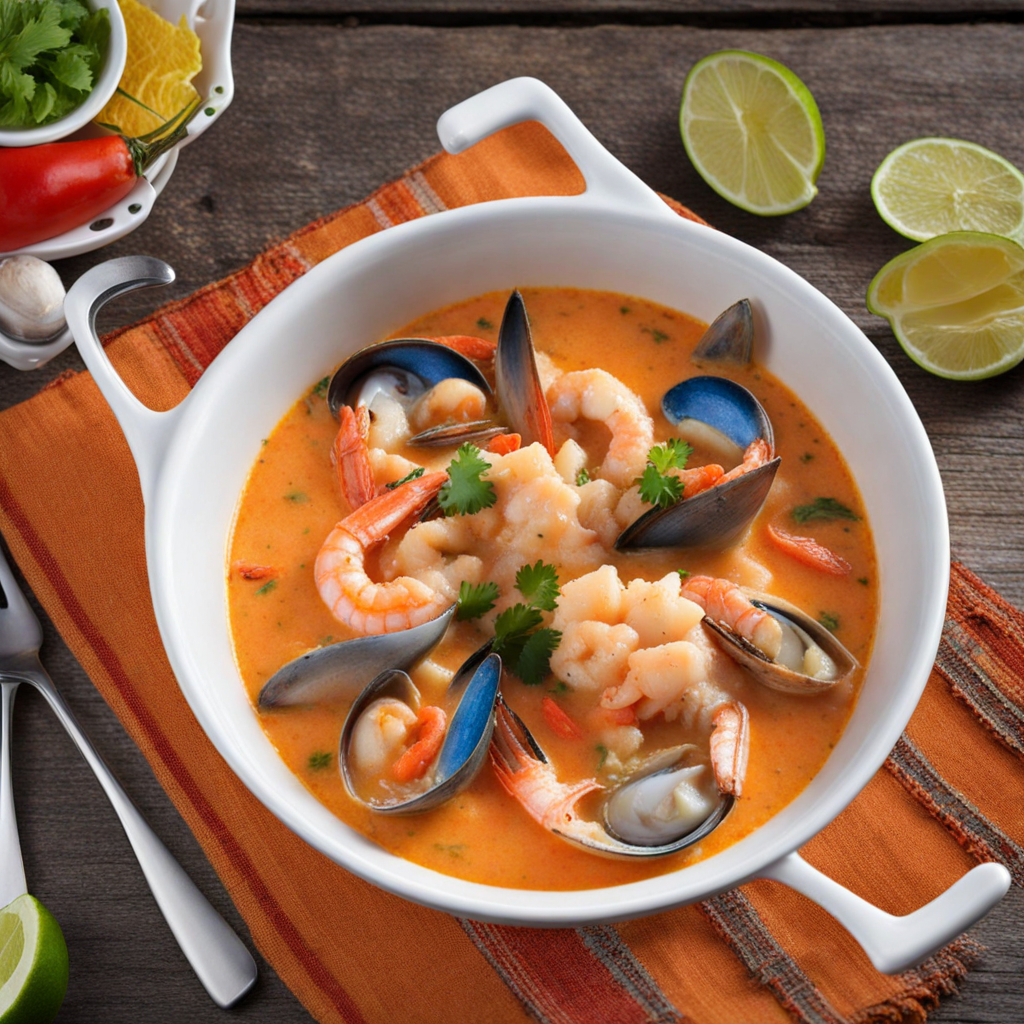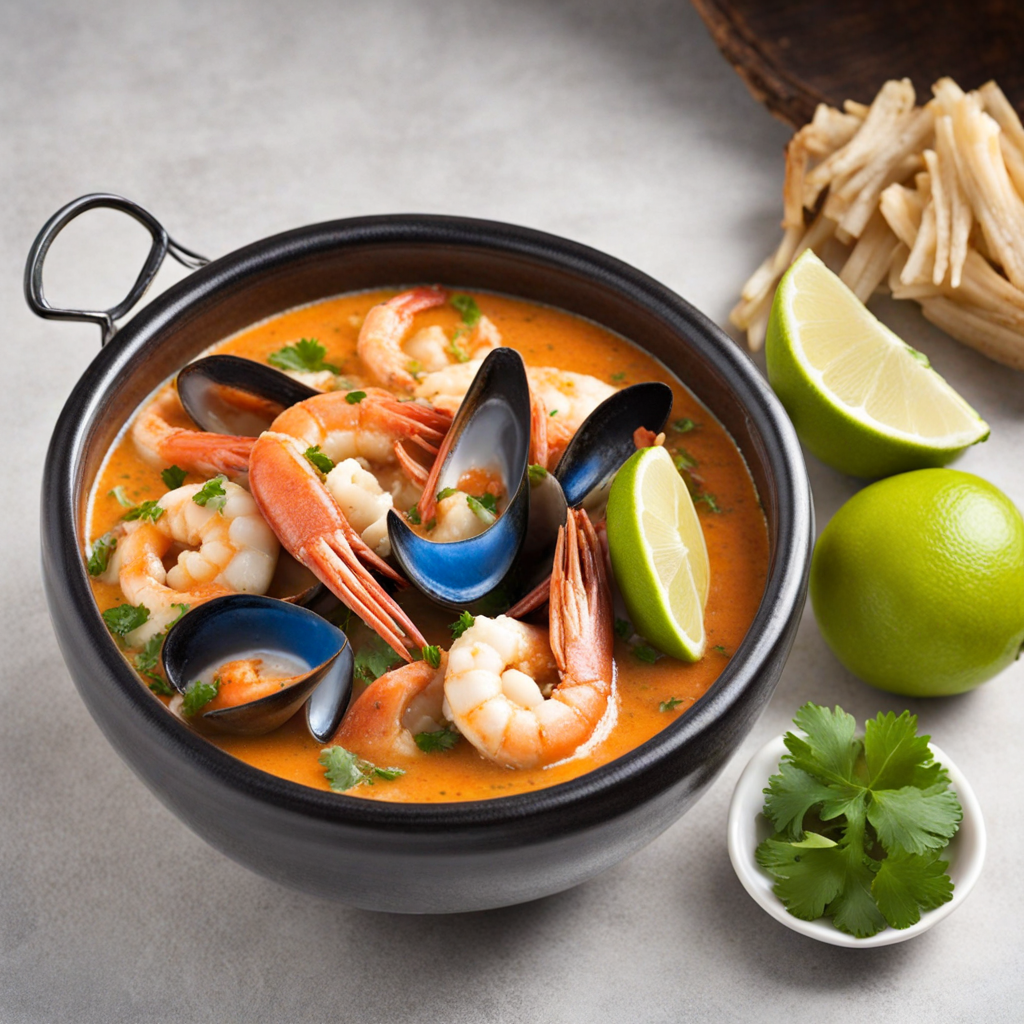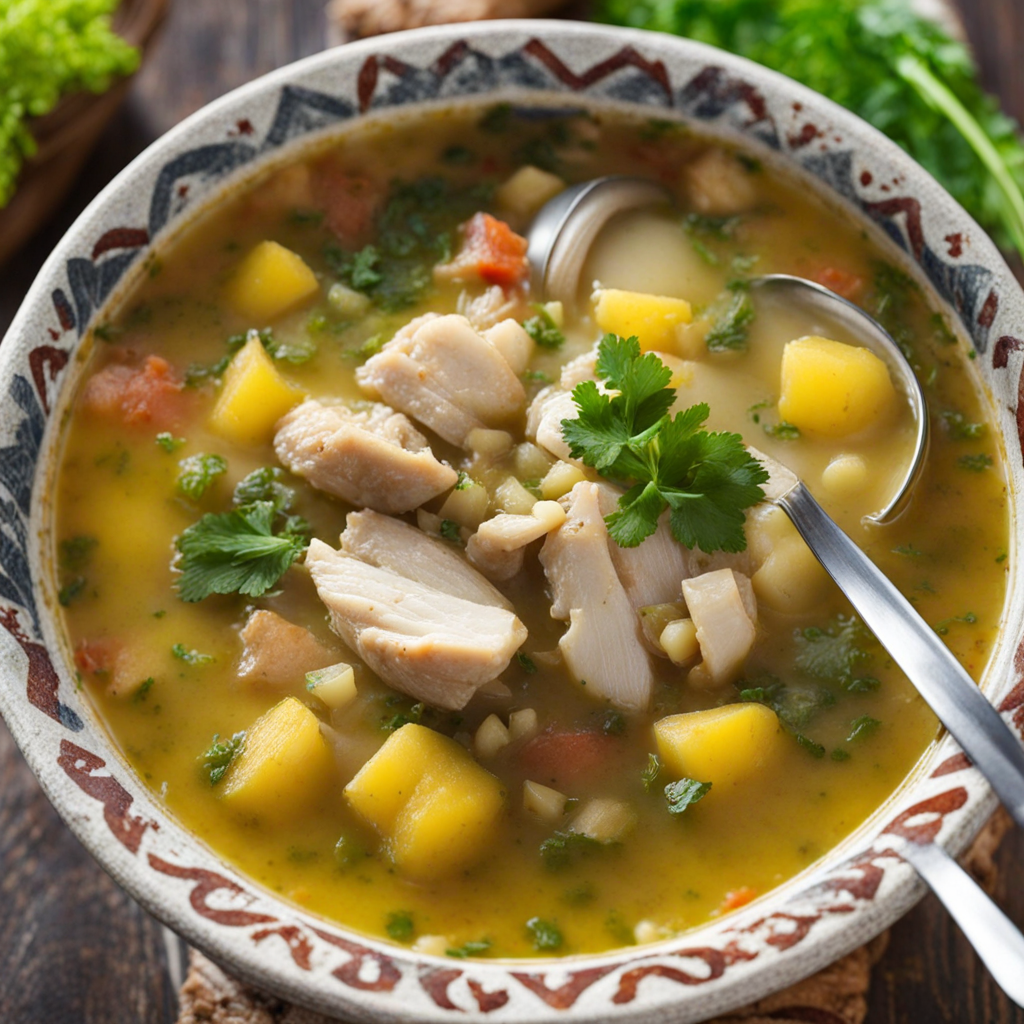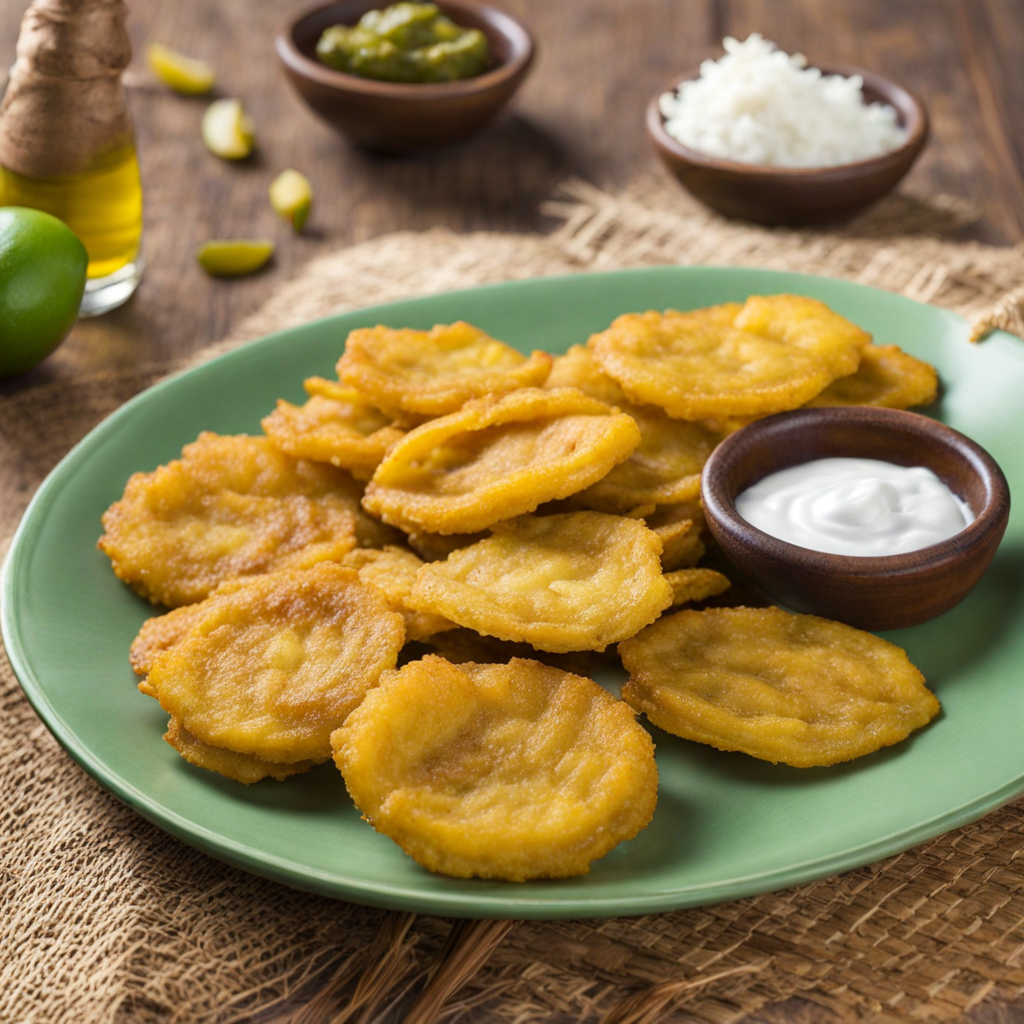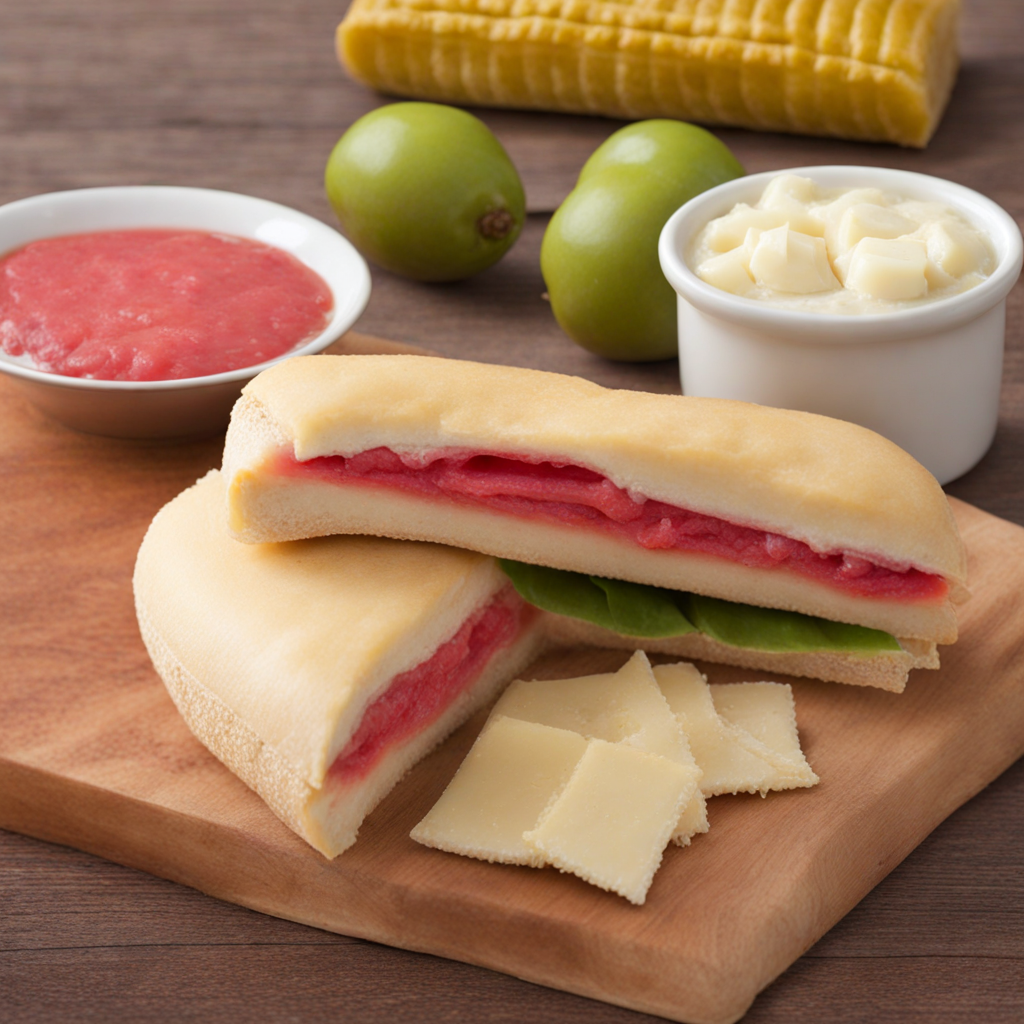Cazuela de Mariscos
Cazuela de Mariscos is a traditional Colombian seafood dish that embodies the vibrant flavors of the Caribbean coast. This delectable stew is a delightful medley of fresh seafood, often including shrimp, fish, and mussels, all simmered in a rich, aromatic broth. The base of the cazuela is typically made with coconut milk, which imparts a creamy sweetness and a hint of tropical essence. Complemented by a blend of spices such as garlic, cumin, and paprika, each bite bursts with the flavor of the ocean, transporting you to the sun-drenched shores of Colombia. The dish is not just about the seafood; it’s also enriched with a variety of vegetables. Chopped onions, bell peppers, and tomatoes are sautéed to create a flavorful sofrito, which forms the backbone of the stew. The addition of fresh herbs like cilantro adds a touch of brightness, while a squeeze of lime juice enhances the dish’s complexity. Cazuela de Mariscos is often served with a side of rice, allowing you to soak up the luscious broth and enjoy the harmonious blend of flavors. This comforting and hearty dish is perfect for sharing, making it a popular choice at family gatherings and celebrations. It showcases the culinary heritage of Colombia, highlighting the country’s abundance of fresh seafood and tropical ingredients. With its inviting aroma and vibrant presentation, Cazuela de Mariscos offers a unique taste experience that is both satisfying and unforgettable, inviting diners to explore the rich tapestry of Colombian cuisine.
How It Became This Dish
Cazuela de Mariscos: A Culinary Journey Through Colombia Cazuela de Mariscos, a vibrant seafood stew, is a beloved dish that encapsulates the rich cultural tapestry of Colombia. This dish, with its origins deeply rooted in the coastal regions, serves as a testament to the country's diverse culinary heritage, blending indigenous, African, and Spanish influences. #### Origins and Historical Context The story of Cazuela de Mariscos begins along Colombia’s Caribbean coast, particularly in regions such as Cartagena, Santa Marta, and Barranquilla, where the bounties of the sea have long been a crucial part of local diets. The word "cazuela" itself is derived from the Spanish term for a cooking pot, which is often used for slow-cooking stews and soups. The indigenous peoples of the region, such as the Tairona and Zenú, relied heavily on the ocean for sustenance, creating dishes that celebrated the marine environment. With the arrival of Spanish colonizers in the 16th century, new ingredients and cooking techniques were introduced to the local cuisine. The Spanish brought with them their culinary traditions, including the use of olive oil, garlic, and various spices. This melding of cultures led to the evolution of many Colombian dishes, including Cazuela de Mariscos. #### Ingredients and Preparation At its core, Cazuela de Mariscos features a variety of fresh seafood, often including fish, shrimp, octopus, and sometimes crab or mussels. What truly sets this dish apart is its rich broth, typically made from a base of coconut milk, which lends a creamy texture and a subtle sweetness that complements the seafood. The addition of fresh herbs, such as cilantro and green onions, alongside traditional spices like cumin and paprika, elevates the dish, making it a symphony of flavors. The preparation of Cazuela de Mariscos is a communal affair, often bringing families and friends together in the kitchen. Traditionally, it is cooked in a "cazuela," a clay pot that retains heat well and allows for even cooking. The seafood is combined with sautéed onions, garlic, and tomatoes, simmered in coconut milk, and finished with fresh herbs. This method not only enhances the flavors but also reflects the communal spirit of Colombian culture, where food is often a catalyst for gathering and celebration. #### Cultural Significance Cazuela de Mariscos is more than just a dish; it is a cultural artifact that tells the story of Colombia’s coastal communities. In regions where fishing is a vital part of the economy, this dish serves as a celebration of the ocean’s bounty. It is commonly found at festive occasions, family gatherings, and even in upscale restaurants that showcase Colombia’s culinary sophistication. The dish also has deep ties to Afro-Colombian traditions. The African diaspora in Colombia, particularly along the Pacific coast, has contributed significantly to the country’s culinary landscape. Techniques such as slow-cooking and the use of coconut milk in savory dishes can be traced back to African influences. Cazuela de Mariscos embodies this fusion, standing as a representation of resilience and cultural blending. In addition, the dish is often enjoyed alongside traditional sides such as arepas (corn cakes) or patacones (fried green plantains), highlighting the importance of staple foods in Colombian cuisine. The communal aspect of sharing a pot of Cazuela de Mariscos emphasizes the values of family and togetherness, making it a staple at celebrations, holidays, and gatherings. #### Evolution and Modern Trends As Colombia has evolved, so has Cazuela de Mariscos. In contemporary times, chefs have begun to experiment with the traditional recipe, incorporating modern culinary techniques and innovative ingredients while still honoring the dish’s roots. Some variations include the use of spicy sauces or the inclusion of non-traditional seafood, expanding its appeal beyond conventional boundaries. Moreover, the rise of Colombia’s gastronomic scene has brought renewed attention to regional dishes like Cazuela de Mariscos. Chefs committed to showcasing Colombian culinary heritage have popularized this dish on international stages, presenting it as a symbol of Colombia’s diverse flavors and culinary craftsmanship. Food festivals and culinary tourism have also spotlighted Cazuela de Mariscos, enticing visitors to explore the coastal regions and experience the dish in its authentic setting. #### Global Influence and Recognition Cazuela de Mariscos has found its way to international menus, reflecting the global appreciation for Latin American cuisine. As Colombian restaurants proliferate in major cities around the world, this dish serves as an ambassador of Colombian culture. The emphasis on fresh, local ingredients and the celebration of culinary traditions resonate with modern diners who are increasingly interested in sustainability and authenticity in their food choices. In recent years, food enthusiasts have begun to recognize the importance of traditional dishes like Cazuela de Mariscos in the context of food heritage. Initiatives aimed at preserving culinary traditions have spurred interest in regional dishes, encouraging younger generations to learn the recipes and techniques passed down through families. #### Conclusion Cazuela de Mariscos is more than just a seafood stew; it is a vessel of history, culture, and community. From its indigenous roots to its Spanish influences and African contributions, the dish embodies the rich tapestry of Colombia’s culinary heritage. As it continues to evolve and adapt in the modern culinary landscape, Cazuela de Mariscos remains a cherished dish that connects people to their history and to each other. In every bowl of Cazuela de Mariscos, there is a story waiting to be told—a story of the sea, of family gatherings, and of the enduring spirit of Colombian cuisine. This dish not only nourishes the body but also feeds the soul, reminding us of the power of food to bring people together and celebrate cultural identity. Whether enjoyed on a sun-kissed beach or in the heart of a bustling city, Cazuela de Mariscos invites everyone to partake in its rich legacy, making it a timeless treasure of Colombian gastronomy.
You may like
Discover local flavors from Colombia


